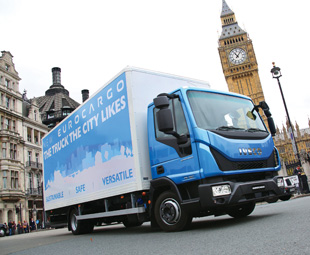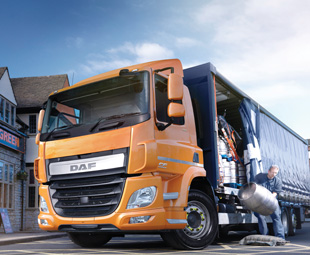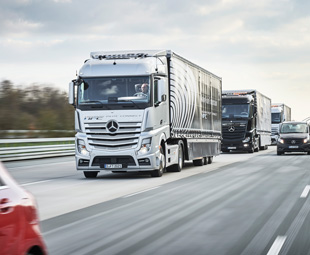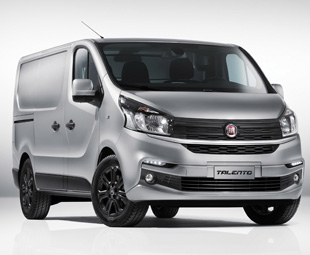Exploring similarities between the UK and SA

In his monthly review of global news for local truckers, FRANK BEETON looks at some interesting changes that have manifested in the United Kingdom (UK) truck market, ponders on the local potential for truck platooning, and unpacks an interesting cooperative venture between Fiat and another vehicle manufacturer
The UK operation of Iveco Trucks staged its annual “State of the Nation” market review at its new Basildon headquarters earlier this year. In his presentation, brand and communications director Nigel Emms pointed out some interesting trends that had emerged in the UK market over the past 30 years.
These are particularly noteworthy as that market can be regarded as highly mature and capable of indicating directions that could also manifest in other markets, such as our own, in the years ahead.
Surprisingly, one of the more significant facts was that once business conditions normalise following major recessions, the market typically recovers only to a level some ten to 12 percent below the pre-recession volume.
This has resulted in the total UK market for trucks over six tonnes gross vehicle mass (GVM) shrinking from some 55 000 units in the early 1980s, to around 49 000 units in the mid-1990s, to 44 063 units in 2015.
Increasing asset utilisation
 Emms ascribes the reduction in absolute market volumes to operators proactively taking more productivity out of their assets, with increasing use being made of three-axle truck tractors at 44 t gross combination mass (the legal limit in the UK), high-cube or double-deck trailers, 6×2 rigids (in place of 18 t GVM 4×2 units) and a move upwards from 7,5 t 4x2s to 12 and 16-t GVM units.
Emms ascribes the reduction in absolute market volumes to operators proactively taking more productivity out of their assets, with increasing use being made of three-axle truck tractors at 44 t gross combination mass (the legal limit in the UK), high-cube or double-deck trailers, 6×2 rigids (in place of 18 t GVM 4×2 units) and a move upwards from 7,5 t 4x2s to 12 and 16-t GVM units.
The larger articulated combinations are mainly employed in long-haul operations, while the rigid units have brought greater efficiency to the pallet networks and urban distribution scenarios.
In the construction arena, greater use of four-axle eight-wheelers for truck mixer and tipper applications, in place of three-axle units, has become evident.
In the waste-management industry, the use of larger vehicles as on-road recycling transfer stations replacing landfill, or off-road disposal sites, is said to have reduced the absolute number of collection vehicles, while providing greater efficiency.
Changing dynamics
Emms says that the emergence of e-commerce and home deliveries, parcels, fresh food and fast-track deliveries has increased demand for panel vans that fall below the six-tonne GVM parameter for this truck market.
This infers that the overall commercial vehicle market, including light vehicles, is tending to polarise towards its upper and lower extremities, with new business methodology pulling it down towards the lighter end, and the quest for more productivity providing the upward thrust.
During 2016, 93 490 3,5-t GVM light vans, and 8 001 heavier vans (3,51 to 5,99 t GVM) were sold in the UK, making a combined total of 101 491 integral vans and van-derived units.
In the over six-tonne GVM truck market, DAF retained its lead during 2015, increasing its share from 24,9 percent in 2014 to 26 percent last year. Mercedes-Benz occupied second position (18,3 percent share versus 18,7 percent in 2014), followed by Scania (16,1 percent versus 13,7 percent) and Volvo (12,6 percent versus 11,8 percent).
Ford led the 3,5-t van category with 25,5 percent penetration, narrowly ahead of Mercedes-Benz at 25,1 percent, while the heavier van class was led by Ford (34 percent share), followed by Fiat (24,4 percent) and Mercedes-Benz (23,2 percent).
Iveco (which provided the input for this article through the Truck and Bus Builder newsletter) finished sixth in the truck market (with 7,3 percent penetration), ninth in the light-van category (with 4,6 percent share), and fifth in the heavy-van category (with 3,9 percent share).
What about us?
Making an accurate comparison with the equivalent South African markets has become impossible, because of the continuing refusal by some manufacturers to provide fully detailed and segmented sales data.
The lower reaches of the local market also exhibits very different usage patterns from its UK equivalent, with our light commercial vehicle (LCV) category heavily involved in personal transportation through double-cab bakkies, and a large percentage of integral vans in the medium commercial vehicle (MCV) segment being converted into midibus taxis.
 However, in our long-term analysis of the available data for the local market, we have noted that, in the period since the beginning of 2000, the most significant beneficiary in terms of market share has been the premium payload extra-heavy commercial vehicle (EHCV) segment (over 16 500 kg GVM); which rose from 22,2 percent of the total market, to slightly more than 44 percent in the second quarter of 2015. This, to some extent, echoes the UK experience.
However, in our long-term analysis of the available data for the local market, we have noted that, in the period since the beginning of 2000, the most significant beneficiary in terms of market share has been the premium payload extra-heavy commercial vehicle (EHCV) segment (over 16 500 kg GVM); which rose from 22,2 percent of the total market, to slightly more than 44 percent in the second quarter of 2015. This, to some extent, echoes the UK experience.
The visual evidence of this can be found in the unloading bays of our local shopping centres, where it has become a common sight to see long three-axle freight carriers, or premium payload 6×4 truck-tractors coupled to maximum-length tridem semi-trailers or interlink sets, battling to reverse into confined loading docks (or even through public car parks) to disgorge their loads.
While it makes absolute economic sense to deliver the largest possible quantity of goods using a single prime mover and driver, it should be recognised that these behemoths are often being tasked to deliver to places never intended to accommodate vehicles of their enormous size.
In the more traditional shopping precincts, which do not have dedicated and segregated unloading areas, these rigs inevitably end up sprawled over pavements, obstructing pedestrians and taking up much-needed public parking bays.
Inevitably, the logistics sector will need to take a fresh look at this situation, and they may well decide to more carefully optimise vehicle sizes and configurations in accordance with delivery destinations. In this case, a potentially negative public image may outweigh the economic advantages of oversized delivery vehicles.
TRUCK PLATOONING PROMISES A NEW DIRECTION
As far back as 2010, we started to notice an increasing frequency of references to the development of “autonomous”, or driverless, vehicles in the media. This appeared to be a logical outgrowth of all the driver assist and safety technologies that were becoming increasingly common; not only in top-end luxury cars, but also entry-level runabouts and commercial vehicles.
Common sense told us that if we were able to combine and integrate the likes of electronically managed engines, transmissions, suspensions, braking, lights, cruise control, lane discipline, seatbelt tension, airbags, seats, interior climate control, entertainment, navigation and parking, we could end up with a vehicle that could drive itself.
There was no doubt that this was an achievable objective, but, since that early realisation, the debate has switched more to the practical implications of integrating autonomous vehicles with those still driven by human beings, and making sure that the operating environment is sufficiently pristine to allow for their safe operation.
 Truck manufacturers have not lagged behind their light vehicle counterparts in applying spectacular new technologies to their products. We have already seen fully autonomous units being tested, under controlled conditions, on public roads. Daimler’s parallel efforts with its Mercedes-Benz and Freightliner brands on both German autobahns and North American highways, for example, have recently received considerable publicity.
Truck manufacturers have not lagged behind their light vehicle counterparts in applying spectacular new technologies to their products. We have already seen fully autonomous units being tested, under controlled conditions, on public roads. Daimler’s parallel efforts with its Mercedes-Benz and Freightliner brands on both German autobahns and North American highways, for example, have recently received considerable publicity.
However, the serious potential conflicts that could arise from the premature mixing of driverless trucks with other highly diversified traffic will probably ensure that these highly successful demonstrations do not evolve into normal practice for some years to come. Manufacturers are, nevertheless, sure to continue experimenting with concepts incorporating varying degrees of limited autonomy, which could find earlier acceptance.
The truck platooning concept
Transport operators are engaged in a never-ending search for greater operating efficiencies to improve their financial bottom lines. As fuel makes up a major component of operational cost (especially in long-distance line-haul rigs) much effort has already been put into optimising the shape of heavy truck/trailer combinations, often using “hang-on” aerodynamic devices.
A single rig, or combination travelling on its own, can only achieve so much in terms of drag reduction, but it was soon realised by aerodynamicists that by running several rigs together, head-to-tail with very little separation, considerably greater benefits would result.
However, “tailgating” by drivers at high speed is extremely dangerous and illegal in most civilised countries, but what if we could use inter-vehicle communication through technology to remove drivers from the following vehicles?
Thus, the “truck platooning” concept has emerged. In October, 2015, the Singapore Ports Authority announced a three-year project to trial truck platooning between its two container terminals, using public roads. While the stated objective was to save manpower, with one driver controlling four or five closely following vehicles, the proving of such an operational concept on public roads would represent a considerable breakthrough.
Then, in March it was announced that six truck makers had agreed to participate in the European Truck Platooning Challenge, a project initiated by the Dutch government.
The platoons were set to drive on public roads, crossing national borders, to reach Rotterdam, Netherlands, by April 16. The contestants included Daimler Trucks, DAF Trucks, Iveco, MAN Truck and Bus, and Scania.
In this type of platooning, each vehicle has a driver in its cab, but only the human being in the lead vehicle is actually driving while the trucks run in platoon formation. Control of the trailing vehicles is completely autonomous to ensure safety at high operational speeds.
When the platoon reaches a destination “hub”, it can be split up and the individual drivers then take their mounts on to diverse offloading points.
The Volvo group was set to run at one-second intervals with a wireless connection to ensure that all vehicles were able to brake and accelerate in unison. The Volvo platoon was scheduled to run from Gothenburg in Sweden to Rotterdam via Denmark, Germany and Belgium.
A South African application?
In these two examples of platooning, entirely different priorities were addressed, for example, manpower saving and reduced emissions/fuel consumption. However, in our view, there is another important opportunity that truck platooning could possibly exploit.
In South Africa, we have seen government regularly promoting rail as the preferred mode for long-distance transport, and embarking on a hugely expensive programme of fleet and infrastructure enhancements.
There have also been proposals to build an entirely new standard-gauge, high-speed railway between Durban and Johannesburg. Anyone with a basic knowledge of railway economics will appreciate that this would be a vastly costly exercise.
 However, it has also been mooted, by private sector interests, that a dedicated truck-only road between port and major market would be a more cost-effective solution, removing freight haulage from the increasingly over-utilised public toll-road network, but without the need for the hugely expensive cost of railway construction.
However, it has also been mooted, by private sector interests, that a dedicated truck-only road between port and major market would be a more cost-effective solution, removing freight haulage from the increasingly over-utilised public toll-road network, but without the need for the hugely expensive cost of railway construction.
If this proposal were to be combined with platooning methodology, we can imagine that it would provide most of the benefits of a high-speed railway, plus a great deal of additional flexibility, at a fraction of the cost.
We fear that this solution will not fit current political thinking, being all too easy for the aforementioned private sector to implement and control – but we are putting it out there just in case more common sense and logic someday make an unexpected entrance to this debate.
FIAT PROFESSIONAL FILLS A VAN GAP WITH HELP FROM RENAULT
The Fiat Chrysler Automobiles (FCA) group has recently entered into a number of agreements with other vehicle manufacturers to source products which could fill gaps and exploit opportunities that exist in its own line-up. An early example was the Polish joint venture that produces the Suzuki SX-4 and Fiat Sedici light SUV’s.
More recently, we have noted the evolution of the new Fiat 124 Spider out of Mazda’s new-generation MX-5 roadster, and the emergence of the Fiat Fullback body-on-frame, one-tonne pickup, which has its roots in Mitsubishi Motors Corporation’s Triton.
During March, an announcement was made which extended the process to plug a gap that was about to appear in the Fiat Professional integral van range with the run-out of the one to 1,2-t payload Scudo, which was positioned between the one-tonne Doblo Cargo and the Ducato “heavy van” models.
Named “Talento” (taken from an ancient coin, the “Talent”) the first images of the new model immediately looked familiar, and further investigation revealed that it has, indeed, been spun off from the Renault Trafic, which already has “badge-engineered” siblings in the Opel/Vauxhall Vivaro, reportedly soon to be joined by a Nissan NV300 version.
The Talento will be produced at Renault’s recently enhanced Sandouville plant in northwest France, and be available with a range of turbo and twin-turbo diesel engines rated at up to 110 kW (145 hp).
While the overall appearance has clearly been dictated by the basic Trafic profile, the frontal styling has been adapted to incorporate a Fiat Professional-style grille and badging. We would expect that the Talento will closely follow the Trafic basic specification profile, which includes a payload capacity of 1,2 t, and a load volume of 6 m³.
Money-making opportunities
As we have previously reported, integral panel vans and their spun-off chassis/cab models are big business in Europe, with some models having already achieved multi-million unit sales over their lifetimes.
As applications dictate that these vehicles all look very similar, a number of manufacturers have identified this category as an ideal area for cooperative ventures. This is typified by the Vivaro/Trafic/Primastar collaboration, which will now to be given an additional dimension with the introduction of the Talento.
While we would expect that the Talento will garner the majority of its sales in Europe, another important consideration would be the recent migration of an increasing number of European-style vans across the North Atlantic.
Fiat Professional’s own Ducato and Doblo models have already made the trip, and are now marketed in North America under FCA’s commercial-specialist Ram branding.
It will be interesting to see if the Talento or any of its siblings follow suit, bearing in mind that some adaptation, such as the substitution of petrol for diesel power, and re-badging, have been perceived as necessary to ensure success in that area.
Global FOCUS is a monthly update of international news relating to the commercial vehicle industry. It is compiled exclusively for FOCUS by Frank Beeton of Econometrix.
Published by
Focus on Transport
focusmagsa




